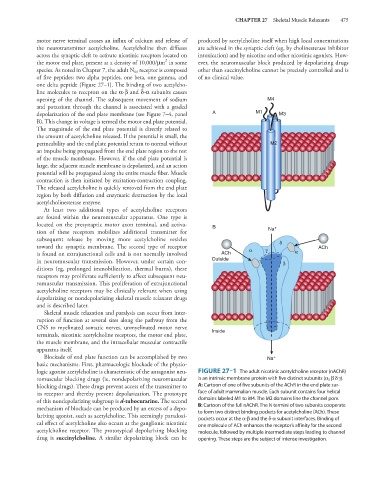Page 489 - Basic _ Clinical Pharmacology ( PDFDrive )
P. 489
CHAPTER 27 Skeletal Muscle Relaxants 475
motor nerve terminal causes an influx of calcium and release of produced by acetylcholine itself when high local concentrations
the neurotransmitter acetylcholine. Acetylcholine then diffuses are achieved in the synaptic cleft (eg, by cholinesterase inhibitor
across the synaptic cleft to activate nicotinic receptors located on intoxication) and by nicotine and other nicotinic agonists. How-
2
the motor end plate, present at a density of 10,000/μm in some ever, the neuromuscular block produced by depolarizing drugs
species. As noted in Chapter 7, the adult N receptor is composed other than succinylcholine cannot be precisely controlled and is
M
of five peptides: two alpha peptides, one beta, one gamma, and of no clinical value.
one delta peptide (Figure 27–1). The binding of two acetylcho-
line molecules to receptors on the α-β and δ-α subunits causes
opening of the channel. The subsequent movement of sodium M4
and potassium through the channel is associated with a graded
depolarization of the end plate membrane (see Figure 7–4, panel A M1 M3
B). This change in voltage is termed the motor end plate potential.
The magnitude of the end plate potential is directly related to
the amount of acetylcholine released. If the potential is small, the
permeability and the end plate potential return to normal without M2
an impulse being propagated from the end plate region to the rest
of the muscle membrane. However, if the end plate potential is
large, the adjacent muscle membrane is depolarized, and an action
potential will be propagated along the entire muscle fiber. Muscle
contraction is then initiated by excitation-contraction coupling.
The released acetylcholine is quickly removed from the end plate
region by both diffusion and enzymatic destruction by the local
acetylcholinesterase enzyme.
At least two additional types of acetylcholine receptors
are found within the neuromuscular apparatus. One type is
located on the presynaptic motor axon terminal, and activa- B +
tion of these receptors mobilizes additional transmitter for Na
subsequent release by moving more acetylcholine vesicles
toward the synaptic membrane. The second type of receptor δ ACh
is found on extrajunctional cells and is not normally involved ACh α γ α
in neuromuscular transmission. However, under certain con- Outside β
ditions (eg, prolonged immobilization, thermal burns), these
receptors may proliferate sufficiently to affect subsequent neu-
romuscular transmission. This proliferation of extrajunctional
acetylcholine receptors may be clinically relevant when using
depolarizing or nondepolarizing skeletal muscle relaxant drugs
and is described later.
Skeletal muscle relaxation and paralysis can occur from inter-
ruption of function at several sites along the pathway from the
CNS to myelinated somatic nerves, unmyelinated motor nerve
terminals, nicotinic acetylcholine receptors, the motor end plate, Inside
the muscle membrane, and the intracellular muscular contractile
apparatus itself.
Blockade of end plate function can be accomplished by two Na +
basic mechanisms. First, pharmacologic blockade of the physio-
logic agonist acetylcholine is characteristic of the antagonist neu- FIGURE 27–1 The adult nicotinic acetylcholine receptor (nAChR)
romuscular blocking drugs (ie, nondepolarizing neuromuscular is an intrinsic membrane protein with five distinct subunits (α 2 β δ γ).
blocking drugs). These drugs prevent access of the transmitter to A: Cartoon of one of five subunits of the AChR in the end plate sur-
its receptor and thereby prevent depolarization. The prototype face of adult mammalian muscle. Each subunit contains four helical
of this nondepolarizing subgroup is d-tubocurarine. The second domains labeled M1 to M4. The M2 domains line the channel pore.
mechanism of blockade can be produced by an excess of a depo- B: Cartoon of the full nAChR. The N termini of two subunits cooperate
to form two distinct binding pockets for acetylcholine (ACh). These
larizing agonist, such as acetylcholine. This seemingly paradoxi- pockets occur at the α-β and the δ-α subunit interfaces. Binding of
cal effect of acetylcholine also occurs at the ganglionic nicotinic one molecule of ACh enhances the receptor’s affinity for the second
acetylcholine receptor. The prototypical depolarizing blocking molecule, followed by multiple intermediate steps leading to channel
drug is succinylcholine. A similar depolarizing block can be opening. These steps are the subject of intense investigation.

